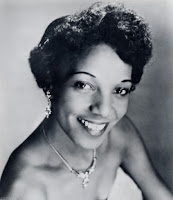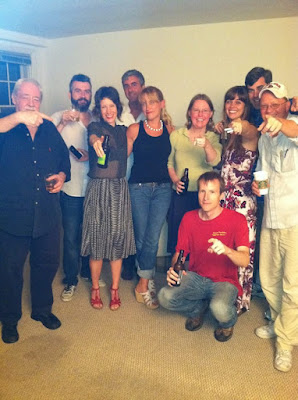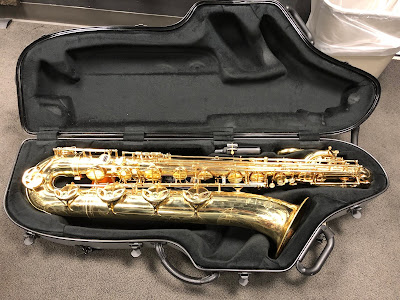Top, left to right: Barbara Lynn, Ella Mae Morse
Bottom, left to right: Big Maybelle, Jackie Shane
Bottom, left to right: Big Maybelle, Jackie Shane
It’s hard to imagine the evolution of American music without
the contributions made by these singers, whose work brashly inhabits at least ten
genres: swing, jazz, blues, jump blues, rhythm & blues, electric blues, rock
‘n’ roll, gospel, soul, and pop. Some of the songs contributed formatively to
the nascent states of their genres. These ladies built a formidable idiom
during the Jump Blues and “Shakers” periods, which roughly accounted for the
twenty-five year stretch from World War II up until the British Invasion. Their
voices howl and holler, they croon and brood, they scat and bounce.
The singers didn’t bring their voices alone to the stage. Nellie
Lutcher, Martha Davis, Camille Howard, Cleo Brown, and Aretha Franklin played
the piano; surely you remember Aretha Franklin in The Blues Brothers. She wasn’t the only actress from this group.
Ruth Brown, LaVern Baker, Sylvia Sims, and Mabel King (What’s Happening!) were actresses, too. Marylyn
Scott and Sister Rosetta Tharpe played guitar. Little Sylvia played guitar; later,
as Sylvia Robinson, she went on to found Sugar Hill Records and played an
irreplaceable role in formation of hiphop music. Barbara Lynn appeared in the
2015 documentary I Am The Blues and
continues to play guitar. Irma Thomas is still active. Sugar Pie DeSanto was,
and still is, a dancer. Big Mama Thornton played drums and harmonica. Jackie
Shane identified as female; she passed away this year after her work,
long-neglected, came back into focus with a Grammy nomination. Shane first performed
her hit single, “Any Other Way,” in Toronto, backed by Frank Motley, who often
played two trumpets simultaneously.
To say that many of these tunes simply concern “love
relationships” would grossly underestimate their contents. When Nancy Adams
narrates all the activity in her “orchard,” she does so from a gangster
standpoint, threatening to take “[her] gun and rat-a-tat-tat” that cat who’s “picking
at [her] plum tree.” Irma Thomas and Sugar Pie DeSanto sing about the need (as
jilted lovers) to leave town altogether while Rose Mitchell and Jo Ann
Henderson both plead for a “baby” to stay, as they perform two different
versions of the same song. Dolly Cooper doesn’t mince lyrics in establishing a
certain ferocity of passion in “Wild Love,” and similarly, Nellie Lutcher urges
her partner to “Hurry on down” since there “ain’t nobody home but [the singer].”

Left: Dolly Cooper, right: LaVern Baker
Some songs describe earthy forms of celebration. Camille
Howard’s “Fiesta In Old Mexico,” Marylyn Scott’s “Beer Bottle Boogie,” LaVern
Baker’s “Dix-A-Billy,” and the voice of Helen Lancaster in “The Monkey Swing”
call to mind jumping juke joints and house rent parties. Big Maybelle and Ann
Cole recorded the first versions of iconic songs that later came to be
standards for Bill Haley and Muddy Waters, respectively. A dark horse candidate
for the best among these songs is the Martha Davis tune, “Sarah Sarah,” which
conjures the earnest life of a seamstress in a shoeshine shop. Of course, male
characters abound. From a “little boy” to a “baby” to a “hound dog” to “Henry”
to “Johnny Lee” to the singer Percy Mayfield (of “Mercy Mister Percy”), these
ladies sure do address the fellas. Cleo Brown predicted—“Here’s the news / And
it’s the newest”—that Jim Braddock would meet Joe Louis, two years after her
song appeared. And they did meet, and Louis knocked out Braddock in what would
become a comeuppance that reinforced the message in Brown’s song.
I hope that many of these musicians will be new to you, as
they were to me. Seek-out the songs. Play them loud. Jump about. Shake your
entire body, then shake individual body parts, one by one. Most importantly,
figure out some way to compensate me for bringing this music into your life. I’d
like you to know that I accept most—but not all—forms of stout, and
stout-porter, and porter. Inquire via modern inquiry techniques, if you will,
and you will. Oh yes. Amen. Also, please refer to our Jump
Blues post, our Shakers
post, and our Unassailable
Vocalists post, even as there may be some minor differences between the
opinions and lists published therein. Hoy hoy!
Irma Thomas “Break-A-Way” (1964)
Discography information appears below
Top 30 Records
Nellie Lutcher: “Hurry On Down” (1947) [Capitol, A-side b/w “The Lady’s In Love With You”]
Martha Davis: “Sarah
Sarah” (1948) [Jewel B-side b/w “When I Say Goodbye”]
Camille Howard: “Fiesta In Old Mexico” (1949) [Specialty
A-side b/w “Miraculous Boogie” ]
Marylyn Scott: “Beer Bottle Boogie” (1950) [Regent A-side
b/w “Uneasy Blues”]
Little Sylvia: “Little Boy” (1951) [Savoy A-side b/w “How
Long Must I Be Blue”]
Big Mama Thornton: “Hound Dog” (1952) [Peacock A-side b/w
“Night Mare”]
Terry Timmons: “Got Nobody To Love” (1952) [RCA Victor
A-side b/w “I Shouldn’t Have To Cry Over You”]
Varetta Dillard: “Mercy Mr. Percy” (1953) [Savoy A-side “No
Kinda Good, No How”]
Rose Mitchell: “Baby Please Don’t Go” (1953) [Imperial
A-side b/w “Live My Life”]
Ruth Brown: “Hello Little Boy” (1954) [Atlantic B-side b/w
“If I Had Any Sense”]
Blanche Thomas: “You Ain’t So Such A Much” (1954) [Imperial
A-side b/w “Not The Way That I Love You”]
Big Maybelle: “Whole Lotta Shakin’ Goin’ On” (1955) [OKeh
A-side b/w “One Monkey Don’t Stop No Show”]
Marie Knight: “Who Rolled The Stone Away” (1955) [Decca
A-side b/w “Easter Bells”]
Sylvia Sims: “Each Day” (1956) [Decca A-side b/w “Dancing
Chandelier”]
Faye Adams: “Johnny Lee” (1957) [Imperial B-side b/w “You’re
Crazy”]
Dolly Cooper: “Wild Love” (1957) [Ebb B-side “Time Brings
About A Change”]
Tiny Topsy: “Miss You So” (1957) [Federal B-side b/w “Aw!
Shucks Baby”]
Ann Cole: “Got My Mo-Jo Workin’” (1957) [Baton A-side b/w “I’ve
Got A Little Boy”]
Jo Ann Henderson: “Baby Please Don’t Go” (1957) [Phonograph
A-side b/w “Just Leave Me Alone”]
Etta James: “Dance With Me, Henry” (1957-58) [Crown from A Rock ‘N Roll Dance Party]
LaVern Baker: “Dix-A-Billy” (1958) [Atlantic B-side b/w “I
Cried A Tear”]
Mary Ann Fisher: “Put On My Shoes” (1959) [Fire A-side b/w
“Wild As You Can Be”]
Sugar Pie DeSanto: “Going Back Where I Belong” (1960) [Veltone
A-side b/w “Wish You Were Mine”]
Aretha Franklin:
“Won’t Be Long” (1961) [Columbia from Aretha:
With The Ray Bryant Combo]
Mabel King: “Go Back Home Young Fella” (1962) [Amy A-side
b/w “Lefty”]
Barbara Lynn: “You’re Gonna Need Me” (1963) [Jamie B-side
b/w “I’m Sorry I Met You”]
Jackie Shane: “Any Other Way” (1963) [Sue Records A-side b/w
“Sticks And Stones”]
Nancy Adams: “Somebody’s In My Orchard” (1964) [RCA Victor
A-side b/w “You’ve Got To Show Me”]
Irma Thomas: “Break-A-Way” (1964) [B-side b/w “Wish Someone
Would Care”]
Yum Yums: “Gonna Be A Big Thing” (1965) [ABC Paramount
B-side b/w “Looky, Looky (What I Got)”]
+ 5 Early Jumps
Cleo Brown: “When Hollywood Goes Black And Tan” (1935) [Brunswick
A-side b/w “When”]
Helen Lancaster with the Harlem Stompers: “The Monkey Swing”
(1938) [Decca A-side b/w “My Understanding Man”]
Sister Rosetta Tharpe: “Rock Me” (1938) [Brunswick A-side
b/w “Lonesome Road”]
Ella Mae Morse with Freddie Slack And His Orchestra: “Get On
Board Little Chillun” (1942) [Capitol A-side b/w “Old Rob Roy”]
Helen Humes: “Be-Baba-Leba” (1945) [Philo Recordings B-side
b/w “Every Now And Then”]

Top, left to right: Annie Laurie, Dolly Lyon
Bottom, left to right: Wynona Carr, Inez Foxx
+ Also Considered:
Annisteen Allen: “Oo-Ee-Bab-A-Lee-Bob” (1945). Marion
Abernathy aka The Blues Woman: “Voo-it! Voo-it!” (1946). Blue Lu Barker: “A
Little Bird Told Me” (1948). Paula Watson: “Hidin’ In The Sticks” (1948). Albennie
Jones: “Hole In The Wall” (1949). Erline Harris: “Jump And Shout” (1950). Julia
Lee & Her Boyfriends: “Mama Don’t Allow It” (1951). Mabel Scott: “Catch ‘Em
Young, Treat ‘Em Rough, Never Tell ‘Em Nothing” (1951). Margie Day: “Snatchin’
It Back” (1953). Pearl Reaves: “You Can’t Stay Here (Step It Up And Go)” (1955).
Lula Reed: “Rock Love” (1955). Wynona Carr: “Jump, Jack, Jump” (1956). Annie
Laurie: “Rockin’ And Rollin’ Again” (1956). Anita Tucker: “Hop Skip And Jump”
(1956). Dolly Lyon: “Palm Of Your Hand” (1957). Lillian Offit: “Miss You So”
(1957). Fay Simmons: “Hangin’ Around” (1957). Carol Fran: “I Quit My Knockin’”
(1958). Sharon Smith: “I’m Waiting” (1958?). Baby Jean: “Oh Johnny” (1962). Jessie
Mae: “Don’t Freeze On Me” (1962). Inez and Charlie Foxx: “Mockingbird” (1963). Cookie
Jackson: “Do You Still Love Me” (1963). Patti LaBelle and the Blue Bells:
“Academy Award” (1963). Pearl Woods “Stickum Up Baby” (1963).
Sources of Information
Wikipedia, AllMusic Guide, YouTube, Discogs, 45cat, Rock
& Roll Hall of Fame, The Guardian
obituary
on Nellie Lutcher, Nick Tosches The
Unsung Heroes of Rock ‘n’ Roll, Mary Unterbrink Jazz Women at the Keyboard, Black Cat Rockabilly article
on Camille Howard, New York Times obituary
for Sylvia Robinson, Gillian Gaar She’s
a Rebel: The History of Women in Rock & Roll, Last.fm article on Terry Timmons,
Kim Clark’s Record Shack article
on Varetta Dillard, Tony Russell The
Blues: From Robert Johnson to Robert Cray, Jazz Archivist article
on Blanche Thomas, Robert Santelli The
Big Book of Blues, W. K. McNeil Encyclopedia
of American Gospel Music, Black Cat Rockabilly article on
Faye Adams, Bob Eagle and Eric LeBlanc Blues
- A Regional Experience, Black Cat Rockabilly article on Ann
Cole, IMDB page for LaVern
Baker, Bob Gulla Icons of R&B and
Soul, SF Gate article
about Sugar Pie DeSanto, Mary J. Blige profile
of Aretha Franklin at Rolling Stone,
IMDB page for Mabel King, NEA
Heritage Fellowship page for
Barbara Lynn, NPR article
on Jackie Shane, Jeff Hannusch I Hear
You Knockin : The Sound of New Orleans Rhythm and Blues, NEA Jazz Masters article on Cleo Brown, Dan
DeLuca article
on Sister Rosetta Tharpe at Pop Matters, New York Times obituary
for Ella Mae Morse, Whitney Balliett American
Singers: Twenty-Seven Portraits in Song.
In addition to Irma Thomas
(vocals), personnel may have included: Jessie Willard Carr (guitar), Paul
Hornsby (keyboards), Pops Powell (bass), Squirm (drums), Swamp Dogg (piano), and the Blossoms (backup vocals).
All other instruments, if any, and additional vocals, if any, unknown. Recorded in 1964 as
a B-side b/w “Wish Someone Would Care” on Imperial Records No. 66013.


































